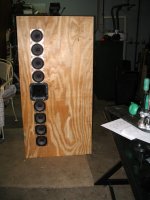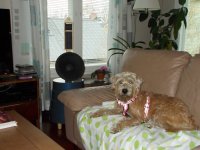Why is not more people using the ESS Air Motion Tweeter for these types of projects? They go far down into the midrange making a three or even a two way system possible. Please tell me what I am missing as I am about to attempt this very soon...
AMT's are usually relatively large. If you want to maintain dipole behavior to the highest possible frequency, large diaphragms should be avoided. Nevertheless, something like a Eton ER4 might be very usable. It can be crossed quite low and isn't as large as some other AMT's. Mundorf has some nice offerings too, but they are either too large, or can not be crossed over lower than a Neo3W.
AMT's are usually relatively large. If you want to maintain dipole behavior to the highest possible frequency, large diaphragms should be avoided. Nevertheless, something like a Eton ER4 might be very usable. It can be crossed quite low and isn't as large as some other AMT's. Mundorf has some nice offerings too, but they are either too large, or can not be crossed over lower than a Neo3W.
Unless you waveguide them. Check my thread in planars and exotics, and the last couple pages of geddes on waveguides for an idea what I'm talking about. The importance is the front-rear symmetry and constant directivity- both of which can be achieved.
Dipole Behaviour
Pardon my ignorance but why does not the Heil AMT Air Motion tweeter behave like a dipole? Yes it is a large tweeter/mid but I think it is the main reason why it sounds so natural? Never understood how a small tweeter can capture the sound of the big cymbal ; ). I thought dipole only represented the figure eight polar patterns so please give me a crash course if you can?
AMT's are usually relatively large. If you want to maintain dipole behavior to the highest possible frequency, large diaphragms should be avoided. Nevertheless, something like a Eton ER4 might be very usable. It can be crossed quite low and isn't as large as some other AMT's. Mundorf has some nice offerings too, but they are either too large, or can not be crossed over lower than a Neo3W.
Pardon my ignorance but why does not the Heil AMT Air Motion tweeter behave like a dipole? Yes it is a large tweeter/mid but I think it is the main reason why it sounds so natural? Never understood how a small tweeter can capture the sound of the big cymbal ; ). I thought dipole only represented the figure eight polar patterns so please give me a crash course if you can?
Unless you waveguide them. Check my thread in planars and exotics, and the last couple pages of geddes on waveguides for an idea what I'm talking about. The importance is the front-rear symmetry and constant directivity- both of which can be achieved.
Hey Badman, I am just getting into OB and this is a pic of the project I built this weekend. I used the JBL 6x6 wave guide with the Selenium 210.
Attachments
Pardon my ignorance but why does not the Heil AMT Air Motion tweeter behave like a dipole? Yes it is a large tweeter/mid but I think it is the main reason why it sounds so natural? Never understood how a small tweeter can capture the sound of the big cymbal ; ). I thought dipole only represented the figure eight polar patterns so please give me a crash course if you can?
No problem.
The figure of eight is characteristic of dipole behavior. It happens when the distance between the front and the back is small compared to the wavelengths at play. At higher frequencies the wavelengths become smaller. When the wavelength approaches the width of the driver of baffle the dipole behavior falls apart. Therefore, if you want to maintain dipole behavior to the highest possible frequency, you want a dipole tweeter to be relatively small.
Badman, I'll check it out! Thanks.
No problem.
The figure of eight is characteristic of dipole behavior. It happens when the distance between the front and the back is small compared to the wavelengths at play. At higher frequencies the wavelengths become smaller. When the wavelength approaches the width of the driver of baffle the dipole behavior falls apart. Therefore, if you want to maintain dipole behavior to the highest possible frequency, you want a dipole tweeter to be relatively small.
OK but looking how many people mount there dipole tweeters on a baffle why would the AMT Great Heil behave any differently? Or to put the question more clearly, what will be lost in the sound experience using them in a dipole set up as the tweeter?
AMT's are usually relatively large. If you want to maintain dipole behavior to the highest possible frequency, large diaphragms should be avoided. Nevertheless, something like a Eton ER4 might be very usable. It can be crossed quite low and isn't as large as some other AMT's. Mundorf has some nice offerings too, but they are either too large, or can not be crossed over lower than a Neo3W.
I use the Mundorf AMT2340, cross over as low as 1700 Hz. It is too wide for perfect dipole pattern above 3-4 kHz, but we simply have to accept that I think. Its much better than those wide-baffle solutions we often see around here though....
The measurements shown below are taken at the following angles: 0 - 15 - 30 - 45 - 60 - 75 - 90, distance 1 meter, anechoic MLS measurement smoothed 1/6 oct
An externally hosted image should be here but it was not working when we last tested it.
Hi,
I was offered the opportunity to listen to the dipoles built by keyser...
Amazing. Stunning. One of the best speakers I ever heard. They completely disappeared into the music. Just as loudspeakers should. Really amazing, seriously considering to build something like this myself although I am not good at diy in general.
I was offered the opportunity to listen to the dipoles built by keyser...
Amazing. Stunning. One of the best speakers I ever heard. They completely disappeared into the music. Just as loudspeakers should. Really amazing, seriously considering to build something like this myself although I am not good at diy in general.
How about doing a vertical polar response on the Neo 3. Observe where the "edges" of the 6db down point are and move the tweeter up by that much, followed by an aggregate vertical polar of the mid-high combination. Some sort of damping on the upper frame of the mid might help. After all, wave lengths at 2k are getting fairly short...
Cheers!
Cheers!
keyser
it was nice to jump to this your old project - it has been one of my inspirations for AINOs and how to approach directivity measurements.
What are you listening now in June 2013? What's cooking? Is the signature project done?
Hi Juhazi,
Sorry I missed your post two years ago!
Since 2010 I've tried quite a few very different kinds of speakers, from CBT's to a cardioid with waveguide and from a more or less omni-directional speaker to floor-to-ceiling line-arrays. All have their strengths and weeknesses. CBT's and line-arrays have a certain 'softness' about their sound (which I both like and dislike sometimes); they're very easy to listen to and sound good almost anywhere in the room. The omni's sound great. Very natural and neutral, but you shouldn't listen to the from too far away, because you'll hear too much of the room. I think uni-directional speakers (cardioid with waveguide) are most 'accurate' and un-colored because they don't illuminate the room as much. They'll let you hear exactly what's on the recording. They sound very direct and they sort of constantly demand your attention - kind of the opposite of what I experience with CBT's and line-arrays. For the last year and a half floor-to-ceiling line-arrays have been my primary speakers.
The last couple of months I'm thinking about building a pair of dipoles again. Dipoles add a certain spaciousness and naturalness to the sound. Their directivity-index is similar to that of a cardioid/waveguide speaker and in my opinion they have some of that same clarity - albeit to a lesser extent - but the strong front-wall reflection really gives them a particular sound of their own. In my view they are definitely less accurate because of it, but it is a very pleasant 'effect'.
Like I said, I'm thinking about building a pair of dipoles again. I have some ideas to get better dispersion than I achieved with the Unbaffle Dipole, using a 3" upper midrange driver and a pair of back-to-back dome tweeters.
I really like your AINO gradients by the way!
Thank you keyser for the post and I agree with all your considertations of lines, wgs and dipoles! I haven't had a chance to hear line arrays/cbts in home environment, but still! I agree that dipole bacside radiation should not be damped to get the magic dipole life-like sound (see picture)
I too did end up to using BG Neo mid and tweeter, after trying to go with cones and waveguide-ribbon. All my friends agree that Neo3 dipole really makes magic! Ít is sad that they are out of production now.
Now keyser, please start a new dipole project and try to find substitute for BG Neos! Linkwitz and Kreskowsky seem to be ok with cones&domes, but we know that it is possible to go beyond those!
Digital sound processing is widely accepted in hifi nowdays, and we see new applications for sound radiation manipulation like Kii and B&O 90. New challenges for diy projects...
I too did end up to using BG Neo mid and tweeter, after trying to go with cones and waveguide-ribbon. All my friends agree that Neo3 dipole really makes magic! Ít is sad that they are out of production now.
Now keyser, please start a new dipole project and try to find substitute for BG Neos! Linkwitz and Kreskowsky seem to be ok with cones&domes, but we know that it is possible to go beyond those!
Digital sound processing is widely accepted in hifi nowdays, and we see new applications for sound radiation manipulation like Kii and B&O 90. New challenges for diy projects...
Attachments
Last edited:
Hi Keyser,
Any progress on your new dipole idea?
Unfortunately not. I have moved about half a year ago and the new house takes up a lot of my free time. But when I do get to building another pair of dipoles, I think I might start a new thread.
- Status
- This old topic is closed. If you want to reopen this topic, contact a moderator using the "Report Post" button.
- Home
- Loudspeakers
- Multi-Way
- Unbaffled Dipole

